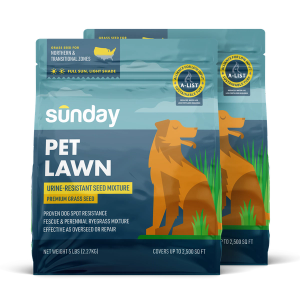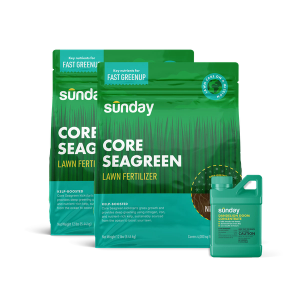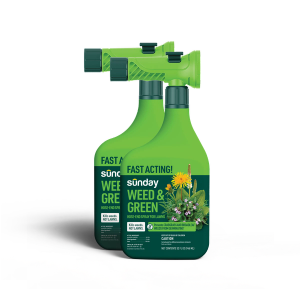What are pet spots?
While cats can be occasional culprits, pet spots are generally dogs' work. Their urine contains lactic acid and urea, which can damage or kill grass when sprayed on concentrated areas.
The result? Those universally hated brown patches that challenge so many pet owners.
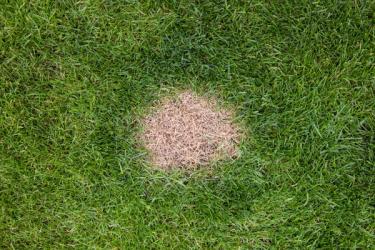
Enter Pet Patch.
Pet Patch is our innovative liquid lawn treatment formulated with hard-working soil remediation ingredients like humic acid, seaweed, and iron that help revive urine-damaged lawn areas.
How it works
- Humic acid: A soil conditioner derived from leonardite, it improves water retention, nutrient reuptake, and soil structure.
- Seaweed: This sustainably harvested plant is rich in minerals and nutrients, helping with heat stress, root development, and overall resilience. It’s also rich in “cytokinins” (aka “stay green” hormones) which help brown grass green up.
- Iron: This essential micronutrient also helps your lawn warm up and green up, and contributes to disease resistance.
- Potassium: One of the big three macronutrients, potassium helps plants convert food into energy and improves resilience to drought and disease.
- Surfactant: This “surface-acting agent” helps water (and nutrients!) penetrate more evenly into the soil and helps the soil hold moisture more effectively. This spurs grass regrowth and distributes urine contaminants to a deeper soil level.
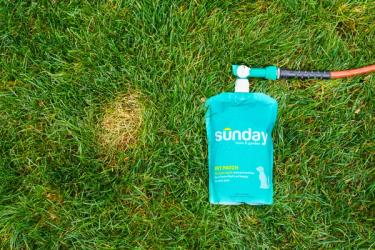
How to repair pet spots
Use Pet Patch for both spot treatments and full-lawn preventive coverage—your choice.
Apply Pet Patch
Repair damaged spots
- Spray Pet Patch on affected areas for 15 seconds at a distance of 12 inches, thoroughly soaking damaged areas.
- Once all spots are treated, remove the sprayer and use the hose to water the treatment for about 20 seconds thoroughly.
- Patch or overseed your lawn with pet urine-resistant grass seed varieties to reduce pet spots overtime.
One pouch covers approximately 50 large pet spots, and you should see results in 21 days.
For preventive use or entire lawn coverage
Spray the entire pouch contents onto lawns up to 2,500 sq. ft. For best results, water your lawn thoroughly after application. It’s as easy as 1, 2, treat!
- Attach pouch and hose to sprayer
- Spray uniformly across the entire lawn.
- Water your lawn post-application.
- Save your sprayer for next time
Plant new grass
Most warm-season lawns, like St. Augustine, will naturally grow back in barren spots after treatment, but for quicker results, you can add a plug. Bermudagrass can be filled in with seed.
Cool-season lawns like fescue and bluegrass spread more slowly, so we recommend patching the damaged area with grass seed after application.
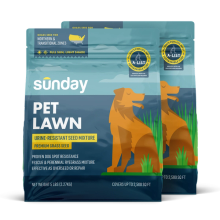
Pet Lawn Grass Seed (2-pack)
- Urine-resistant grass seed mixture
- Perennial rye and tall fescue mix
- A-LIST-approved varieties
- High 85% germination rate
- 99.9% weed-free guarantee
Prevent pet spots long term
An ounce of prevention, so they say, is worth a pound of cure. Here are three tricks that may reduce the likelihood of pet spots:
Plant urine-resistant grass seed
Want something scientifically proven to help prevent pet spots? Meet Pet Lawn Grass Seed. Over 160 grass seed varieties were tested to create this mixture that's resistant to pet pee and stands up to pet play, too. Overseed your entire lawn with this revolutionary pet-safe product.
Good old H2O
If you happen to be in the yard when your dog is urinating, you can immediately water the area—thus diluting the urine—as a preventive measure.
Does your pet have a preferred potty zone? Consider setting up a sprinkler to water that area more frequently. In general, keep your lawn well hydrated so that it’s less sensitive to stressors.
Pet training
Some dog owners train their fur friends to go only to one spot in the yard. This can be an area that does not have grass growth or a place on the lawn that they know will have to be maintained with closer care.
Start by taking your dog to the designated area, name it “spot” or “place,” and then offer a reward when the dog succeeds.
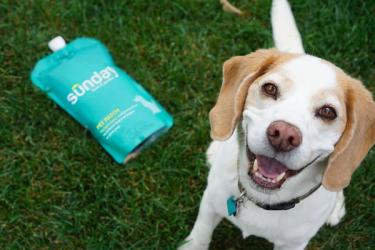
Isn’t it a relief to know you can keep your dog AND your lawn happy? From the beginning, we designed Sunday with your family and pets in mind, using friendly ingredients that don’t involve scary yellow flags or post-application waiting periods.
We want you to enjoy your lawn, and if that enjoyment comes with pet spots, well, you know where to look for help.









